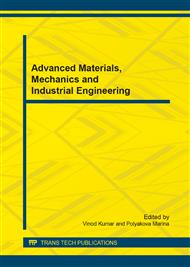[1]
M. A. Hamstad, A Review: Acoustic Emission, a Tool for Composite-Materials Studies. Experimental Mechanics, 26 pp.7-13 (1986).
DOI: 10.1007/bf02319949
Google Scholar
[2]
W. Yoshinori, I. Ken-Ichi, S. Kazuhiko, F. Yoshiaki, B. Rao, G. Hua and L. Xun, A Modeling Method on Fractal Distribution of Cracks in Rocks Using AE Monitoring. J. Acoustic Emission 23 (2005).
Google Scholar
[3]
F. F. Barsoum, J. Suleman, A. Korcak and E. V. K. Hill, Acoustic Emission Monitoring and Fatigue Life Prediction in Axially Loaded Notched Steel Specimens. Journal of Acoustic Emission. Vol. 27, 40-63 (2009).
DOI: 10.1061/41171(401)203
Google Scholar
[4]
M. Kalicka, Acoustic Emission as a Monitoring Method in Prestressed Concrete Bridges Health Condition Evaluation. Journal of Acoustic Emission, 27, 18-26 (2009).
Google Scholar
[5]
L. M. Spasova, M. I. Ojovan and C. R. Scales, Acoustic emission technique applied for monitoring and inspection of cementitious structures encapsulating aluminium. Acoustic Emission, 25, 51-68 (2007).
Google Scholar
[6]
L.B. Freund, Dynamic Fracture Mechanics. Cambridge University Press (1998).
Google Scholar
[7]
C. U. Grosse, and M. Ohtsu, Acoustic Emission Testing - Basics for Research-Applications in Civil Engineering. Springer Verlag, Berlin & Heidelberg, Germany (2008).
Google Scholar
[8]
R. Burridge and L. Knopoff , Body force equivalents for seismic dislocations. Bull. Seismol. Soc. Am., 54, 1875-1888 (1964).
DOI: 10.1785/bssa05406a1875
Google Scholar
[9]
G.E. Backus and M. Mulcahy, Moment tensors and other phenomenological descriptions of seismic sources. – I. Continuous displacements, Geophys. J. Roy. Astron., Soc., 46, 341-361 (1976a).
DOI: 10.1111/j.1365-246x.1976.tb04162.x
Google Scholar
[10]
G.E. Backus and M. Mulcahy, Moment tensors and other phenomenological descriptions of seismic sources – II. Discontinuous displacements, Geophys. J. Roy. Astron., Soc., 47, 301-329 (1976b).
DOI: 10.1111/j.1365-246x.1976.tb01275.x
Google Scholar
[11]
B. L. N. Kennett, Seismic wave propagation in stratified elastic media. Cambridge University Press (1983).
Google Scholar
[12]
M.A. Hamstad, A.O. Gallagher and J. Gary, Effects of lateral plate dimensions on acoustic Emission signals from dipole sources. Journal of Acoustic Emission 19, 258–274 (2001).
Google Scholar


